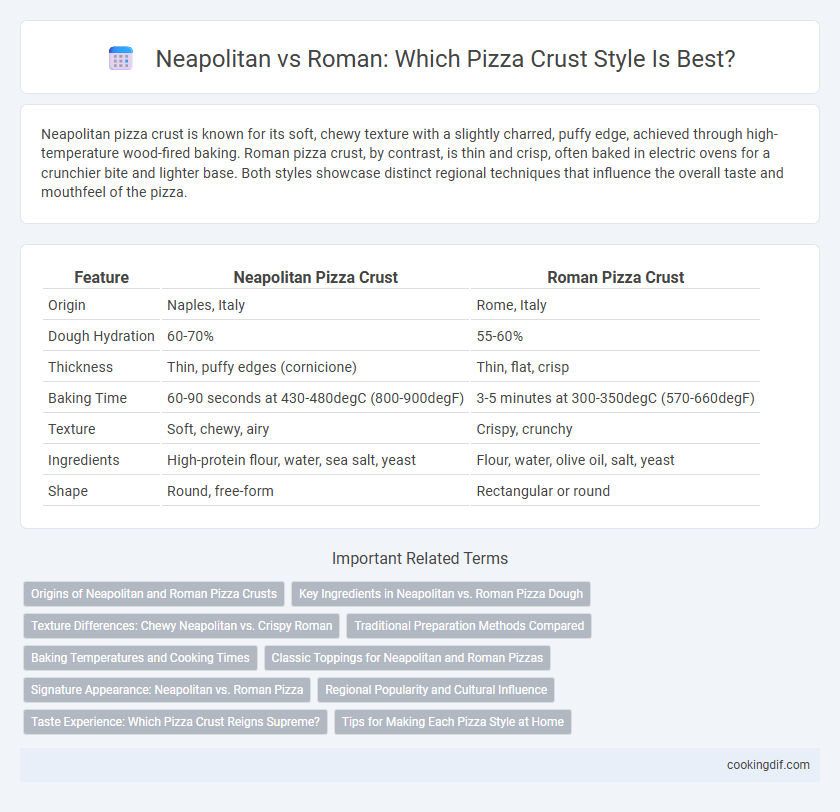Neapolitan pizza crust is known for its soft, chewy texture with a slightly charred, puffy edge, achieved through high-temperature wood-fired baking. Roman pizza crust, by contrast, is thin and crisp, often baked in electric ovens for a crunchier bite and lighter base. Both styles showcase distinct regional techniques that influence the overall taste and mouthfeel of the pizza.
Table of Comparison
| Feature | Neapolitan Pizza Crust | Roman Pizza Crust |
|---|---|---|
| Origin | Naples, Italy | Rome, Italy |
| Dough Hydration | 60-70% | 55-60% |
| Thickness | Thin, puffy edges (cornicione) | Thin, flat, crisp |
| Baking Time | 60-90 seconds at 430-480degC (800-900degF) | 3-5 minutes at 300-350degC (570-660degF) |
| Texture | Soft, chewy, airy | Crispy, crunchy |
| Ingredients | High-protein flour, water, sea salt, yeast | Flour, water, olive oil, salt, yeast |
| Shape | Round, free-form | Rectangular or round |
Origins of Neapolitan and Roman Pizza Crusts
Neapolitan pizza crust originates from Naples, Italy, characterized by its soft, chewy texture and slightly charred edges, achieved through high-temperature wood-fired ovens. Roman pizza crust, hailing from Rome, is typically thinner, crispier, and more aerated, often baked in electric ovens with olive oil enhancing its crunch. Both styles reflect regional ingredients and cooking traditions, influencing their distinct textures and flavors.
Key Ingredients in Neapolitan vs. Roman Pizza Dough
Neapolitan pizza dough relies on soft wheat flour, water, sea salt, and fresh brewer's yeast, resulting in a tender, airy crust with a slightly chewy texture. Roman pizza dough incorporates high-protein wheat flour, water, olive oil, salt, and yeast, creating a thinner, crispier crust with a delicate crunch. The inclusion of olive oil in Roman dough differentiates it from Neapolitan's traditional formulation, impacting texture and flavor.
Texture Differences: Chewy Neapolitan vs. Crispy Roman
Neapolitan pizza crust is characterized by its soft, chewy texture achieved through high hydration dough and short baking times at extremely high temperatures. Roman pizza crust, in contrast, is thin and crispy, resulting from lower hydration dough and longer baking times in moderate heat, which creates a crunchy, cracker-like bite. These textural differences highlight the distinct regional baking techniques and dough formulations that define Neapolitan and Roman pizza styles.
Traditional Preparation Methods Compared
Neapolitan pizza crust is characterized by its soft, airy texture achieved through a slow fermentation of dough using only flour, water, salt, and yeast, followed by high-temperature wood-fired oven baking that creates a charred, leopard-spotted crust. Roman pizza crust traditionally uses higher hydration dough with a longer fermentation time, resulting in a crispier, thinner base often baked in electric or gas ovens at lower temperatures. Both styles emphasize natural fermentation processes and minimal ingredients, but differ significantly in dough hydration, baking temperature, and resulting texture.
Baking Temperatures and Cooking Times
Neapolitan pizza crust is baked at extremely high temperatures, around 900degF (480degC), for a very short time, usually 60-90 seconds, resulting in a soft, airy crust with charred spots. Roman pizza crust, by contrast, is baked at lower temperatures, approximately 572degF (300degC), for a longer duration of 10-15 minutes, producing a thinner, crispier texture. The differences in baking conditions create distinct crust characteristics essential to each traditional style.
Classic Toppings for Neapolitan and Roman Pizzas
Neapolitan pizza crust is soft and chewy with a slight char, traditionally topped with San Marzano tomatoes, fresh mozzarella, basil, and extra virgin olive oil, highlighting simple, high-quality ingredients. Roman pizza crust is thin and crispy, often adorned with a variety of toppings such as prosciutto, artichokes, olives, and shaved Pecorino Romano cheese, emphasizing bold flavors and diverse textures. Both styles showcase regional Italian culinary heritage through their distinctive toppings and crust preparations.
Signature Appearance: Neapolitan vs. Roman Pizza
Neapolitan pizza crust features a puffy, airy edge known as the "cornicione," with a soft, chewy texture and slight charring from high-temperature wood-fired ovens. Roman pizza crust is typically thinner and crispier, often with a flatter, more uniform surface that showcases a golden-brown, crunchy finish ideal for holding varied toppings. The iconic appearance of Neapolitan pizza emphasizes its rustic, domed crust, while Roman pizza stands out with its sleek, cracker-like presentation.
Regional Popularity and Cultural Influence
Neapolitan pizza crust, known for its soft, airy texture and charred edges, holds iconic status in Naples and symbolizes traditional Italian pizza culture worldwide. Roman pizza crust, thinner and crispier, reflects the fast-paced lifestyle of Rome, gaining popularity in urban centers with its emphasis on a light, crunchy bite. Both crust styles influence regional culinary identities, shaping local preferences and tourism-driven pizzerias across Italy and beyond.
Taste Experience: Which Pizza Crust Reigns Supreme?
Neapolitan pizza crust offers a soft, chewy texture with a slightly charred, smoky flavor that enhances the fresh tomato and mozzarella toppings. Roman pizza crust is thinner and crispier, delivering a crunchy bite that contrasts with its rich, savory toppings, creating a distinct taste profile. Preference depends on whether you favor tender, airy dough or a crisp, crackly base that accentuates bold flavors.
Tips for Making Each Pizza Style at Home
Neapolitan pizza crust demands high-hydration dough and a short, intense bake at 900degF using a wood-fired oven or pizza stone to achieve its signature soft, airy texture with charred spots. Roman pizza crust requires a longer fermentation and lower hydration, resulting in a thin, crisp base, best baked at 480-500degF on a steel plate or in a home oven preheated thoroughly. Use Caputo 00 flour for Neapolitan and a blend of 00 and bread flour for Roman to optimize gluten structure and achieve authentic texture.
Neapolitan vs Roman for pizza crust Infographic

 cookingdif.com
cookingdif.com